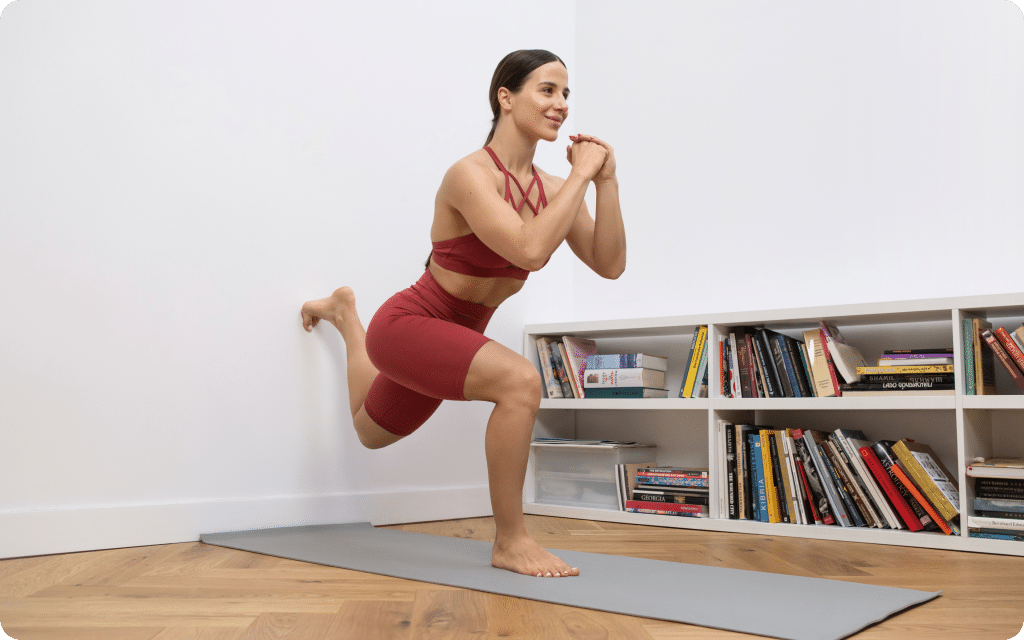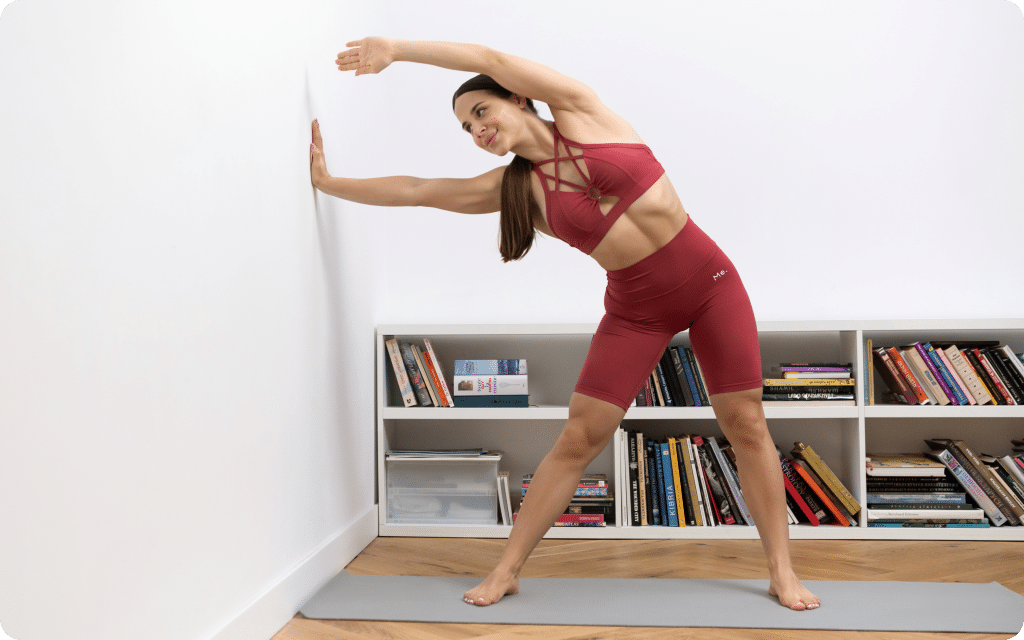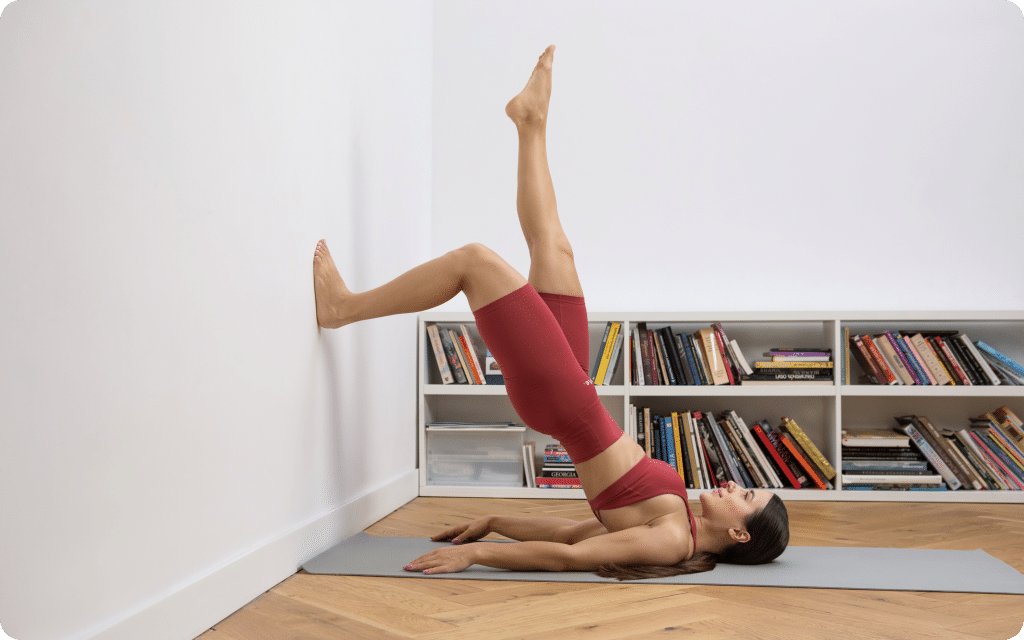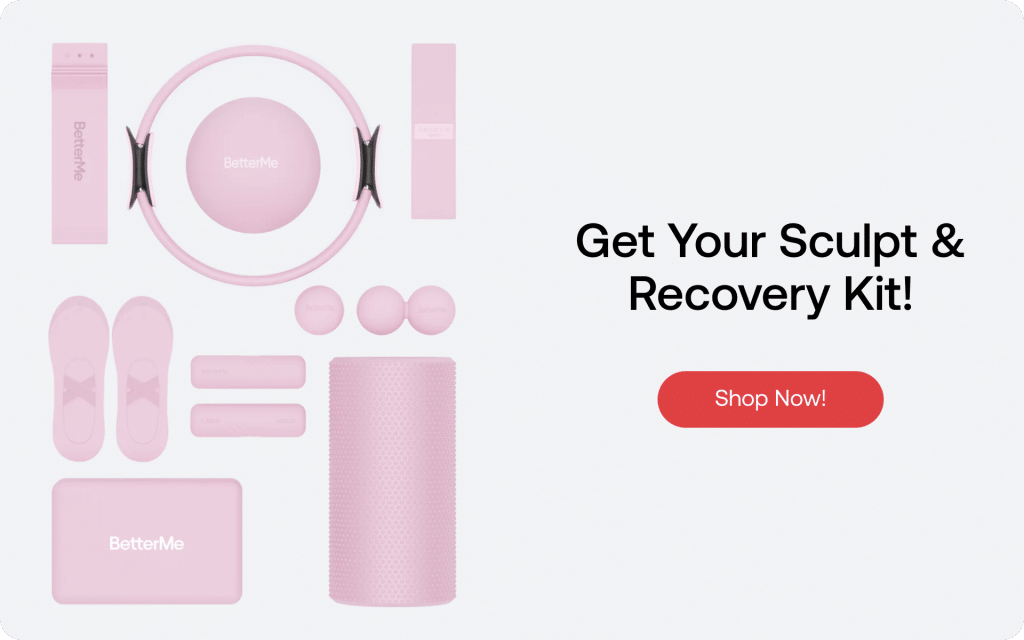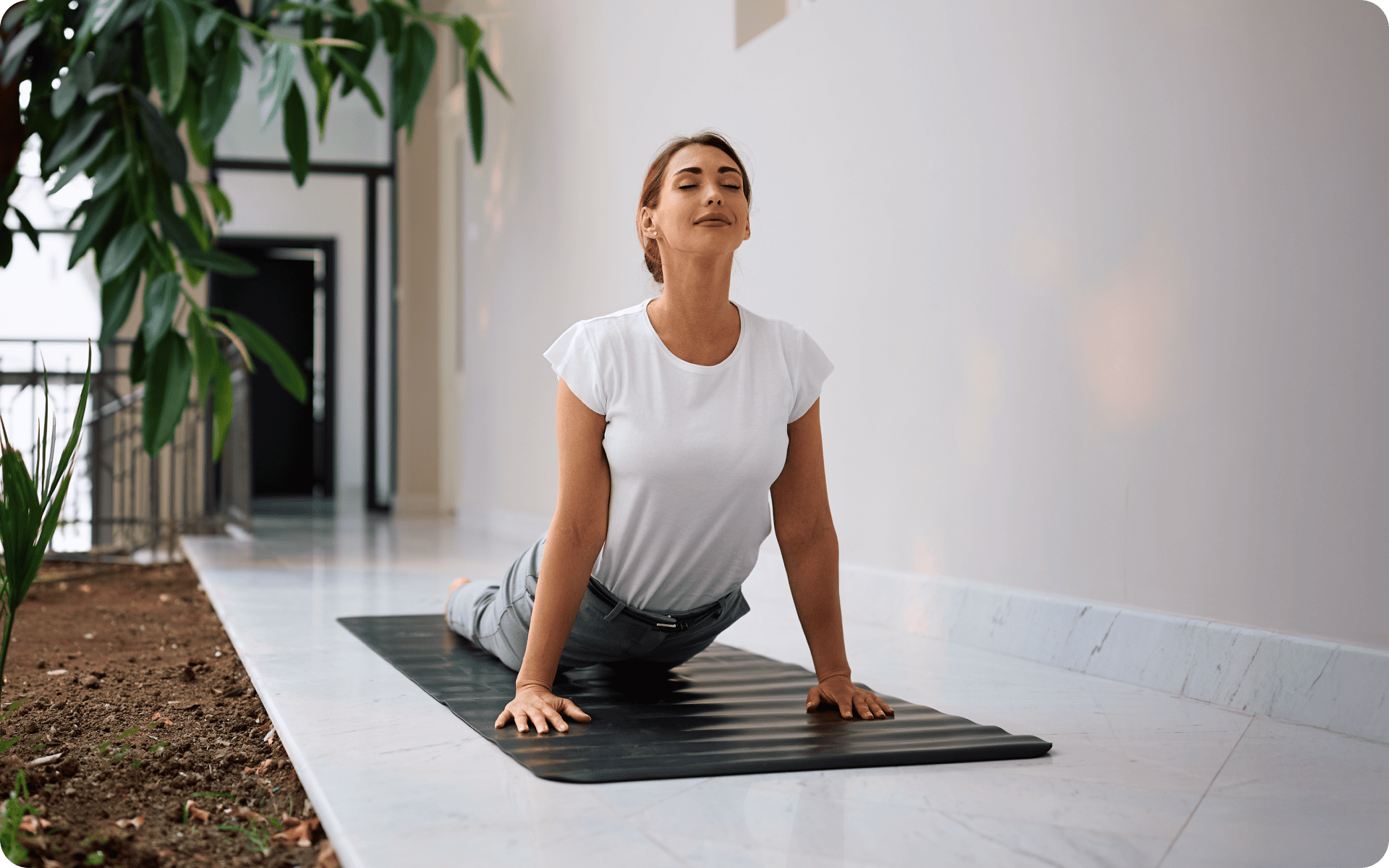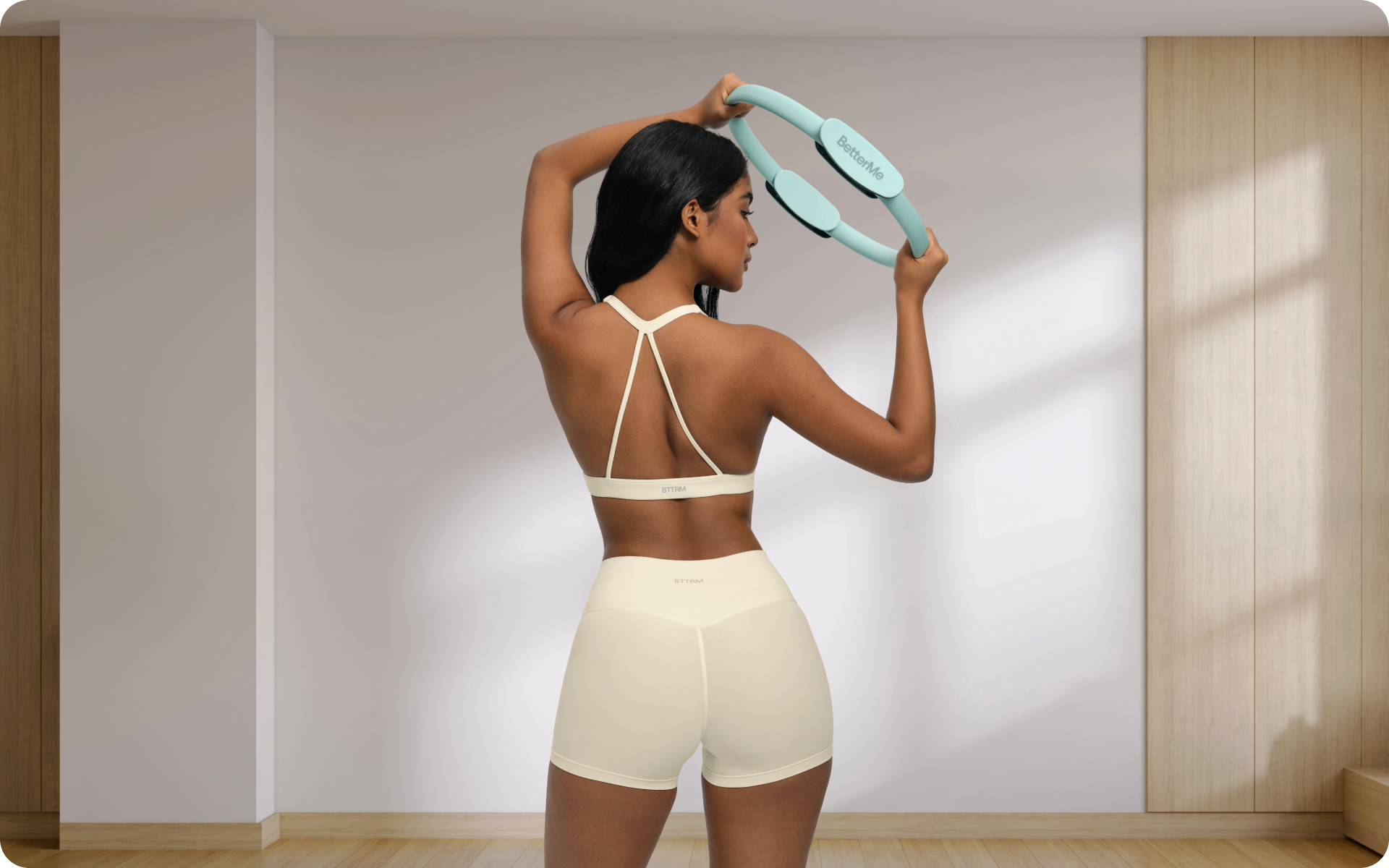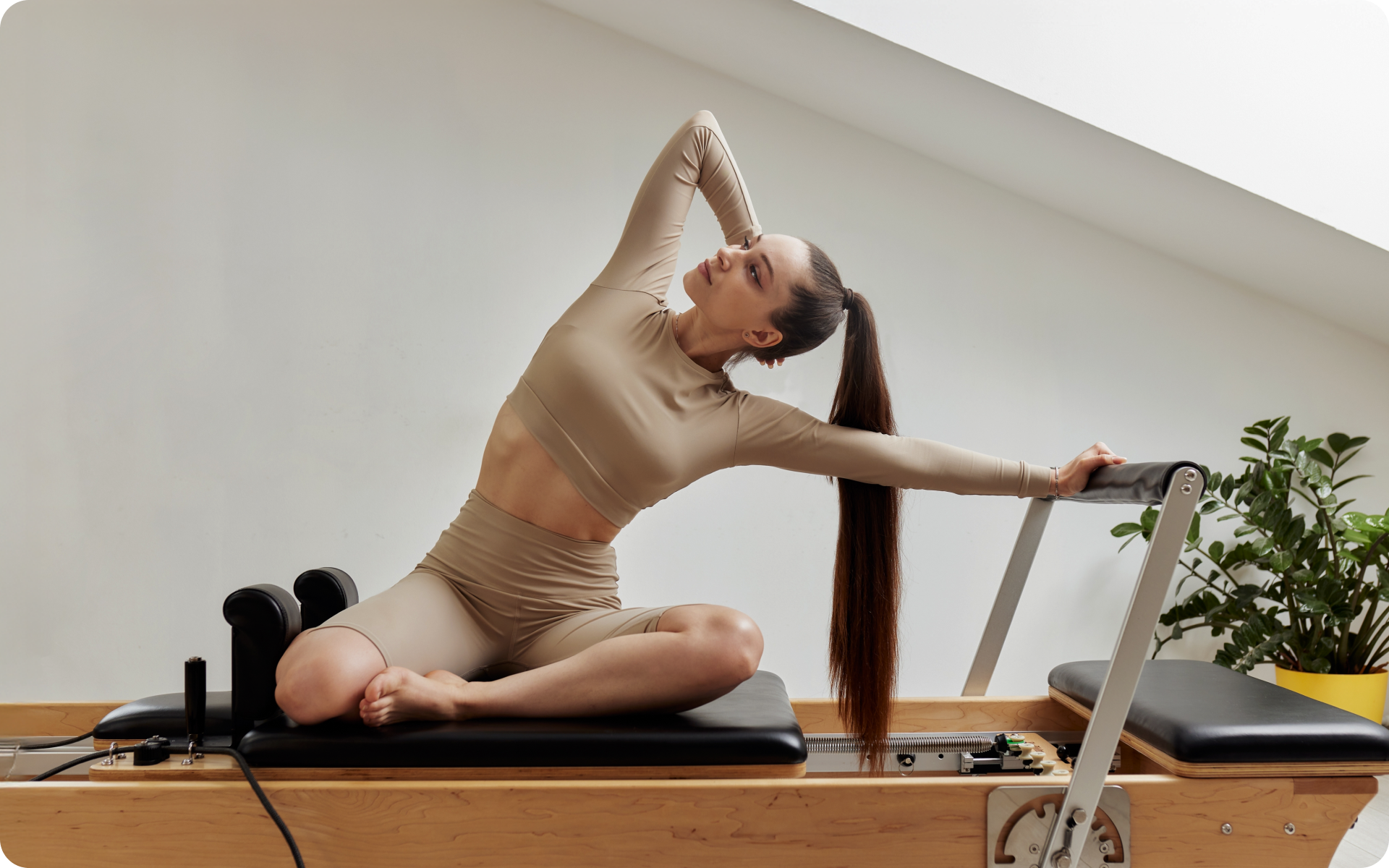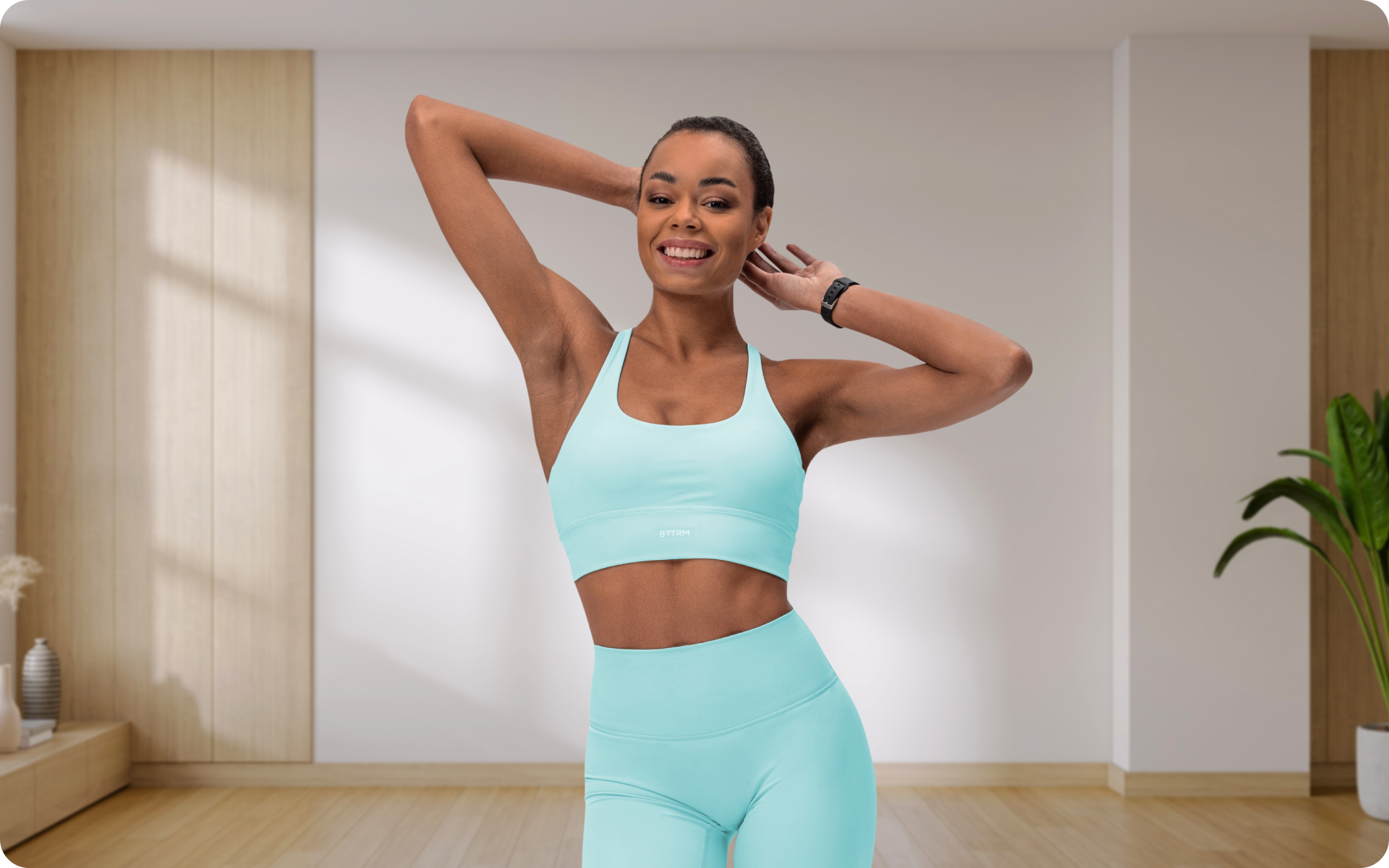As far as we know, nothing beats the gentle, yet powerful burn of Pilates for a low-impact start to your week. No, you won’t need a reformer for these exercises, nor will you have to head out to a pricey boutique studio; that’s totally not in line with our bare-minimum philosophy.
These Pilates arms exercises are ideal for an at-home upper body workout. They are low-impact, require minimal space, and most of all, they effectively target and tone your arms.
Here’s how to start your week on a high, right from the comfort of your home.
Can Wall Pilates Tone Your Arms?
The wall serves as a great prop for Pilates because it helps with stability and adds resistance to your movements. It also allows you to focus on proper form and alignment, which is crucial for targeting specific muscles and avoiding injury. But before we continue, let’s discuss what “toning” really means.
The term “toning” is commonly used in the fitness industry, but mostly is a marketing term. The concept of toning relates to the ability to visibly see muscle definition (e.g., “toned shoulders”). Two things are needed in order to visibly see muscles:
- A low enough body fat percentage in the area (muscle lies below fat)
- Sufficient muscle mass to see muscle definition
That said, the word “toning” is commonly linked to Pilates as this exercise is known for its ability to stretch and strengthen muscles, enhancing flexibility. In particular, Pilates focuses largely on eccentric muscle contractions, which is when the muscles are being lengthened against the force of gravity. This type of muscle contraction is great for strengthening muscles. Furthermore, Pilates also emphasizes isometric contractions, allowing for greater muscular endurance — which is your muscle’s ability to endure an exercise for longer periods of time (e.g., holding a plank) (4).
That said, Pilates usually does not promote large amounts of muscle hypertrophy, or building muscle mass, since this requires progressive overload. Progressive overload is when you gradually increase resistance (e.g., weight lifted or number of reps) as your muscles adapt so that you’re regularly getting your muscles close to failure. This process results in the tearing of muscle fibers that are then rebuilt larger and stronger.
What Pilates will do is help to strengthen and lengthen your muscles, which may help to improve their appearance. When paired with a well-rounded workout program, healthy diet, and good sleeping practices, you may also experience some weight loss, which can further help with muscle definition or “toning”.
Intense sweat sessions, working weight loss tips, lip-smacking recipes come in one package with the BetterMe app. And all of it is at your fingertips, start transforming your life now!
How Do You Lose Arm Fat With Wall Pilates?
It’s important to know that you can’t control where your body loses fat as this is largely based on genetics. Therefore, it’s generally recommended to focus on total fat loss rather than focusing on “spot training”.
As mentioned earlier, visible muscles are a result of reducing body fat percentage. To lose body fat you will need to be in a calorie deficit, meaning you will be burning more calories than you’re consuming. For sustainable weight loss, it’s best to focus on a well-rounded exercise regime that includes resistance training and cardio along with a healthy diet.
Wall Pilates can support this by:
Improving Muscle Quality and Definition
As we mentioned, Pilates effectively strengthens and “tones” your muscles, which can contribute to a more defined appearance.
Burning Calories
While Pilates may not be as calorie-burning as high-intensity cardio workouts, it has been shown in research studies to support weight loss and changes in body composition (7) (10). So when combined with a healthy diet and other forms of exercise, it can contribute to overall fat loss.
Improving Posture
Good posture can give the illusion of a slimmer and toned appearance. The wall serves as an excellent prop for improving posture, especially when focusing on the upper body. It may also help encourage proper movement patterns, allowing for a more effective workout.
Enhancing Overall Fitness
A strong and healthy body is more efficient at burning calories, even at rest. Therefore, incorporating Pilates into your workout routine can help improve overall fitness and contribute to fat loss in the long run (3).
So while wall Pilates alone may not be enough to lose significant arm fat, it can play a role in helping you achieve your goals when combined with other healthy habits.
Read more: Wall Pilates for Butt: A Quick Guide for Beginners
Other Benefits of Wall Pilates for Arms
Aside from strengthening your arms, wall Pilates also offers other benefits for your upper body, including:
Strengthening The Core
Pilates is known for targeting and strengthening the deep core muscles (5). This not only improves stability but also helps in overall strength and fitness (1).
Improving Balance and Coordination
Many wall Pilates exercises require a great deal of balance and coordination to perform correctly. Practicing these movements can help improve your balance and coordination, which is essential for everyday movements.
Reducing Back Pain
Poor posture can lead to back pain, and wall Pilates can help improve posture by strengthening the upper body muscles responsible for supporting the spine. This, in turn, can help reduce any discomfort or pain in that area (8).
Upper Body Wall Pilates Exercise to Strengthen and Tone Your Arms
These wall Pilates arms exercises can help you achieve strong, toned arms by targeting and strengthening the muscles in that area:
Wall Push-Ups
Traditional push-ups are a great exercise that targets the pectorals (a group of muscles located in the chest), triceps (back of the arm), biceps (front of the arm), and deltoids (shoulder muscles). Other supporting muscles include your core and upper back.
Wall push-ups provide a similar effect, with less intensity and pressure on the wrists. Also, you can easily adjust the difficulty level by changing your distance from the wall.
To perform wall push-ups:
- Stand facing the wall with your arms extended at shoulder height and shoulder distance apart, with your hands flat against the wall. Your feet should be hip-width apart. If you feel like you’re reaching, then move slightly closer to the wall.
- Slowly bend your elbows and lean towards the wall until your nose almost touches it. Be sure to keep your back straight and bend your elbows at a 45-degree angle. Avoid bending your elbows out to the sides.
- Push back against the wall, extending your arms to return to the starting position.
- Repeat for 10-12 reps for two sets. Alternatively, continue until you’re just short of failure. Take a minute or two break, and repeat another round.
Tip: For a greater challenge, try countertop push-ups. These follow a similar movement pattern but rely more on the force of gravity, resulting in a greater challenge.
Pilates Ring Squeeze
For this exercise, you will need a Pilates ring. The Pilates ring is a round, flexible ring usually made of metal or rubber. Also known as a magic circle, this 13-15 inch ring provides resistance for a variety of Pilates exercises.
The Pilates ring squeeze works your deep shoulder muscles (rotator cuff) and chest muscles.
To perform the Pilates ring squeeze:
- Stand against the wall with your arms extended at shoulder height and hands holding the Pilates ring.
- Squeeze the ring between your palms, while keeping your elbows bent at 90 degrees.
- Slowly push the ring towards the wall until your arms are fully extended.
- Hold for a few seconds before releasing and repeating for 10-12 reps for two sets.
Whether you’re looking to simply pep up your fitness routine, jazz up your diet with mouth-watering low-calorie recipes or want to get your act together and significantly drop that number on your scale – BetterMe app has got you covered! Improve your body and revamp your life with us!
Wall Extensions
Wall extensions are an excellent way to improve shoulder mobility, stretch the muscles of your chest and shoulder girdle, and provide a gentle workout for your arms.
To perform wall extensions:
- Stand with your back to the wall, feet hip-width apart.
- Extend your arms out to the sides at shoulder level, with your elbows bent at 90 degrees and your palms facing forward.
- Slowly raise your arms up, trying to keep your wrists and elbows touching the wall.
- Lower back down to the starting position.
- Repeat for 10-12 reps for two sets.
Wall Plank
A wall plank is a less intense version of a traditional plank but still works to strengthen your arms, shoulders, and core.
To perform a wall plank:
- Stand facing the wall, about a foot away.
- Lean forward and place your hands flat against the wall, at shoulder height and shoulder width apart.
- Slowly walk your feet back, allowing your body to lean into the wall until you are in a ‘plank’ position. Be sure your body is in a straight line from head to foot.
- Hold this pose for 30 seconds to a minute, maintaining a tight core. If you begin to dip your hips forward, stop the exercise and restart. Only hold for as long as you can maintain proper positioning.
- Slowly walk your feet back towards the wall to return to the starting position.
- Repeat for 2-3 times.
Wall Angels
Wall angels are excellent for improving your posture and working a wide range of muscles, including the trapezius (upper back), deltoids (shoulder), rhomboids (upper back), and serratus anterior (located along the side of the chest).
To do wall angels:
- Stand with your back pressed against the wall and your feet shoulder-width apart.
- Bring your arms up to form a ‘W’ shape with your elbows and back of the hands touching the wall.
- Slowly slide your arms up the wall to form a ‘Y’ shape, maintaining contact with the wall.
- Slowly slide them back down to the ‘W’ shape. Try to focus on squeezing your shoulder blades as you bring your arms down.
- Repeat for 10-12 reps for two sets.
Wall-Assisted Shoulder Stretch
This stretch targets the chest and shoulder muscles, improving flexibility and range of motion. It can also help alleviate any tension or tightness in that area.
To perform the wall-assisted shoulder stretch:
- Stand facing the wall with your arms extended at shoulder height and palms flat against the wall.
- Slowly lean forward, keeping your arms straight, until you feel a stretch in your chest and shoulders.
- Hold for 30 seconds before releasing and repeating if desired.
Read more: Pilates Full Body Workout for Beginners (No Equipment Needed)
How Long Does It Take To Tone Your Arms With Wall Pilates?
It takes at least 4-8 weeks of regularly practicing wall Pilates exercises to see a noticeable difference in your arms’ tone and definition. Of course, the time frame can vary depending on factors such as the intensity and frequency of your workouts, diet, and overall fitness level.
FAQs
Does Wall Pilates Really Get You In Shape?
Wall Pilates can support fitness levels, especially if you practice it consistently. This practice targets deep muscles, improves balance and posture, and provides a full-body workout.
Over time you will likely notice increased strength, flexibility, and muscle definition in your arms, as well as other parts of your body.
That said, only doing wall Pilates won’t improve your overall fitness levels and won’t likely burn enough calories on its own to support weight loss. With this in mind, you should incorporate these exercises into a larger, more well-rounded workout program.
We discuss this in more detail in our blog: Does Wall Pilates Work?
Is It Better To Do Pilates In The Morning or At Night?
It’s better to do Pilates when you have time for it; be it morning or night.
Exercise timing has minimal impact on its effectiveness. However, some people do prefer to do Pilates in the morning as it can help energize and prepare them for the day ahead. On the other hand, doing exercise like Pilates at night can aid in relaxation and improve sleep quality. However, it’s best to avoid exercising too close to bedtime. Ideally, try to stop exercising at least two hours before going to bed (2).
How Many Calories Does 25 Minutes of Pilates Burn?
Pilates is not typically known for its calorie-burning benefits, but rather for improving muscle strength, flexibility, and overall body tone.
Combining it with other forms of exercise and a healthy diet can help you achieve your desired weight loss goals.
The Bottom Line
Wall Pilates can help you get strong, toned arms. By incorporating these exercises into your workout routine 2-3 times a week, along with maintaining a healthy diet and lifestyle, you can see significant results in as little as 4-8 weeks.
For best results, vary your exercises, increase the intensity gradually, and focus on proper form to avoid injury.
DISCLAIMER:
This article is intended for general informational purposes only and does not serve to address individual circumstances. It is not a substitute for professional advice or help and should not be relied on for making any kind of decision-making. Any action taken as a direct or indirect result of the information in this article is entirely at your own risk and is your sole responsibility.
BetterMe, its content staff, and its medical advisors accept no responsibility for inaccuracies, errors, misstatements, inconsistencies, or omissions and specifically disclaim any liability, loss or risk, personal, professional or otherwise, which may be incurred as a consequence, directly or indirectly, of the use and/or application of any content.
You should always seek the advice of your physician or other qualified health provider with any questions you may have regarding a medical condition or your specific situation. Never disregard professional medical advice or delay seeking it because of BetterMe content. If you suspect or think you may have a medical emergency, call your doctor.
SOURCES
- Core Stability Exercise Principles : Current Sports Medicine Reports (2008, journals.lww.com)
- Effect of Pilates on Sleep Quality: A Systematic Review and Meta-Analysis of Randomized Controlled Trials (2020, frontiersin.org)
- Exercise and weight loss: the importance of resting energy expenditure – Harvard Health (2015, health.harvard.edu)
- Pilates: how does it work and who needs it? (2011, ncbi.nlm.nih.gov)
- Pilates (2011, ncbi.nlm.nih.gov)
- Pilates Exercise: Lessons From the Lab (2011, ideafit.com)
- Pilates for Overweight or Obesity: A Meta-Analysis (2021, frontiersin.org)
- Pilates to Improve Core Muscle Activation in Chronic Low Back Pain: A Systematic Review (2023, ncbi.nlm.nih.gov)
- Posture – Physiopedia (n.d., physio-pedia.com)
- The effect of Pilates exercise on body composition in sedentary overweight and obese women (2017, pubmed.ncbi.nlm.nih.gov)

